In Esther Latrobe’s memoir, as the reader, we learn that Esther Latrobe was born at Bristol on June 7th, 1802 into a loving family of five brothers and two parents. As she grew up she battled many illnesses such as the measles. To add to Esther’s rough upbringing, her mother passed when Esther was eleven years old. She then spent a lot of time in a dear place, Tytherton. She still had battles with illnesses such as rheumatic fever, which often required the Lord’s spirits to restore her as her medical assistants could not. Because of this attachment with her saviour she put her heart into the Lord. She had a deep connection with her faith that developed from a young age into her adulthood. Esther Latrobe then gave birth to a boy which caused her to become very sick. The way she connected with the Lord made her fear of death simmer. She felt comfort with her loved ones by her side as she faded into life with the Lord, death. She died at the age of 28.
With the use of Voyant Tools I was able to, as Frank Moretti states “step back and look at the broad patterns that emerge” (Whitley 188). These tools allowed me to see the most frequent words as well as the trends in the text. These tools gave me new perspective on the memoir including a broad view on the answer to our research question. Our research question was how did Esther Latrobe’s relationship with God affect her lifestyle, and help her recover from such illnesses and hardships. Seeing the frequency of the word “Lord” and “spirits” helped draw conclusions on how big an influence these had during this medical crisis of her life. Although it didn’t draw in specifically on how the Lord and spirits impacted her life as that would require a closer reading of her memoir, it was mentioned enough for the reader to realize that it played a big role.

With the ability of Voyant Tools I was able to see that the most frequent words were “lord”, “oh”, “dear”, “god” and “heart” (which is tied with “let” and “said”) respectively. Being able to see this showed what had the biggest influence in Esther’s life as she had the most to say about it. Even better, the context on Voyant Tools allows you to see to the left and right of the word which allows you to see the context of the Lord in Esther’s life. Being able to see every single occurrence of the word allows you to see much more than the human eye could pick up on. Also the list allows you to compare each occurrence of the word on a visual chart in a very efficient matter that the human could not do alone.
Using the available tools in Voyant Tools helps “identify the patterns of meaning in large and potentially unwieldy texts” (Whitley 198). Word clouds allow you to “spatially read a large body of text involving an interesting back-and-forth between close and distant reading” (Whitley 200). Having these tools helped draw large conclusions about the text which mainly relate back to her beliefs about Lord. Along with Tippett’s memoir, the Lord impacted the lives of many of this time period which shows how important religion was. “Lord” and “Saviour” were frequently used in both memoirs. Using visual tools such as bubblelines, wordcloud, cirrus, bubbles, and frequency grids provides visualizations about the text without reading the entire text. Being able to draw conclusions helps analyze not only Esther’s memoir but also all Moravian memoirs and that time period as a whole.


Carly Pavoni is from Fairfield, CT. She is a freshman at Bucknell University that is undeclared in the arts and sciences school. She is on the track and field team at Bucknell University.
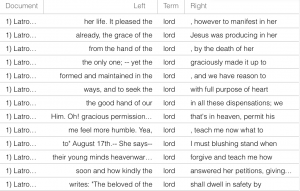
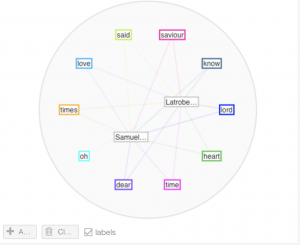
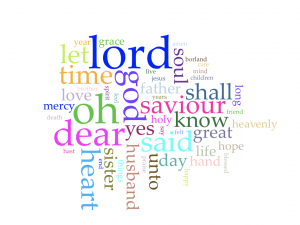
 When looking at the tools that are given it seem that these tools would help us understand more on these research questions. The reason is that many of the traditional tools are usually pen and paper that has only one copy of existence. But in the Digital age that we live, a person is able to access things more quicker and understand the connections of the terms and their usage in that text better and faster. We are able to compare and contrast between text better in finding the differences and “digital technology (help us) search for patterns and trace broad outlines.” (188)
When looking at the tools that are given it seem that these tools would help us understand more on these research questions. The reason is that many of the traditional tools are usually pen and paper that has only one copy of existence. But in the Digital age that we live, a person is able to access things more quicker and understand the connections of the terms and their usage in that text better and faster. We are able to compare and contrast between text better in finding the differences and “digital technology (help us) search for patterns and trace broad outlines.” (188)

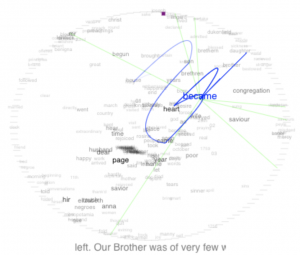 keywords throughout my document in a neat visual. This tool painted out a nice overview of the text, and “creat[ed] visual abstractions of textual patterns” (193), which I used before diving into other tools that gave more detailed data. In a way, I used this tool to see a summary of my document.
keywords throughout my document in a neat visual. This tool painted out a nice overview of the text, and “creat[ed] visual abstractions of textual patterns” (193), which I used before diving into other tools that gave more detailed data. In a way, I used this tool to see a summary of my document. word cloud emphasizes a frequently used to term by making it larger. Observing my word cloud, I was able to see that congregation, heart, saviour, son, and brethren were most frequently used. I did not find any collocates to be particularly useful because no words were associated with another more than once, so no phrases presented themselves as frequently used in the document. These words allowed me to see that Joesph Lingard’s story of how he joined congregation was more instrumental to the text than I originally thought. However, the Document Terms gives the quantitative data to see how many times each of those words were actually used in the specific document, but not the whole corpus. For
word cloud emphasizes a frequently used to term by making it larger. Observing my word cloud, I was able to see that congregation, heart, saviour, son, and brethren were most frequently used. I did not find any collocates to be particularly useful because no words were associated with another more than once, so no phrases presented themselves as frequently used in the document. These words allowed me to see that Joesph Lingard’s story of how he joined congregation was more instrumental to the text than I originally thought. However, the Document Terms gives the quantitative data to see how many times each of those words were actually used in the specific document, but not the whole corpus. For 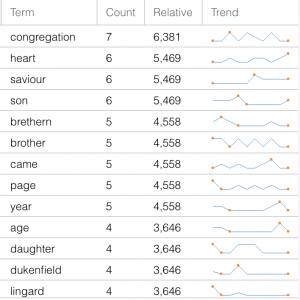 example, Document Terms showed that heart was used 18 times throughout the text and showed a trend line. This trend line is an especially helpful visualization tool in that is shows me where in the text the word is used most frequently, which allows me to ask more questions about that particular section of the document. For example, where the word heart is most frequently used, Joesph was speaking about his journey to join the congregation and how the brethren offered him lodging. Joseph’s frequent usage of “heart” shows that these kind actions deeply affected him. Overall, These tools are helpful because “amid the chaos of more frequent repetitions,” the tools allow me to see patterns that I “may have missed with close reading” (191).
example, Document Terms showed that heart was used 18 times throughout the text and showed a trend line. This trend line is an especially helpful visualization tool in that is shows me where in the text the word is used most frequently, which allows me to ask more questions about that particular section of the document. For example, where the word heart is most frequently used, Joesph was speaking about his journey to join the congregation and how the brethren offered him lodging. Joseph’s frequent usage of “heart” shows that these kind actions deeply affected him. Overall, These tools are helpful because “amid the chaos of more frequent repetitions,” the tools allow me to see patterns that I “may have missed with close reading” (191).